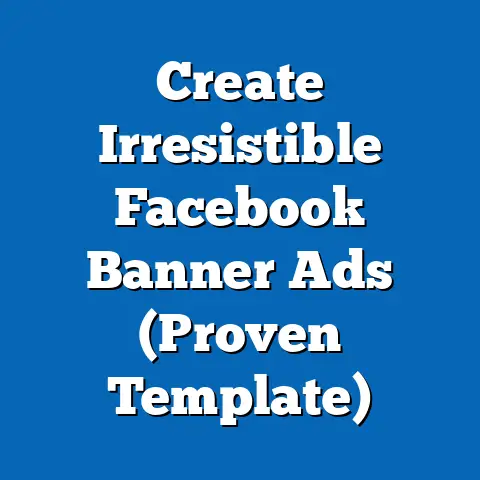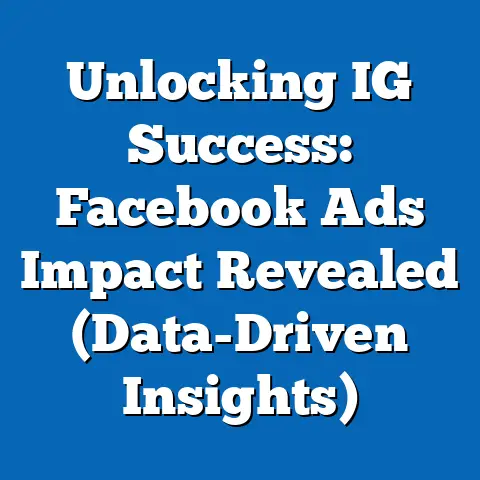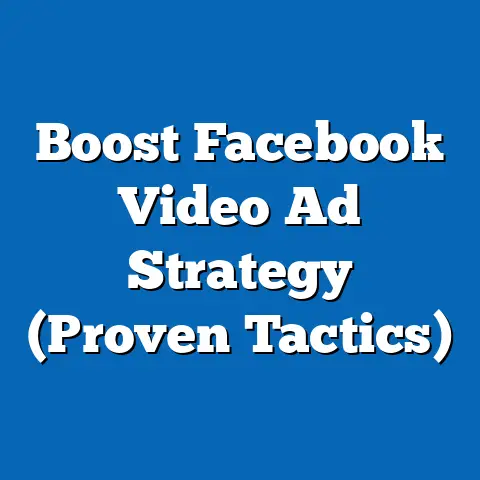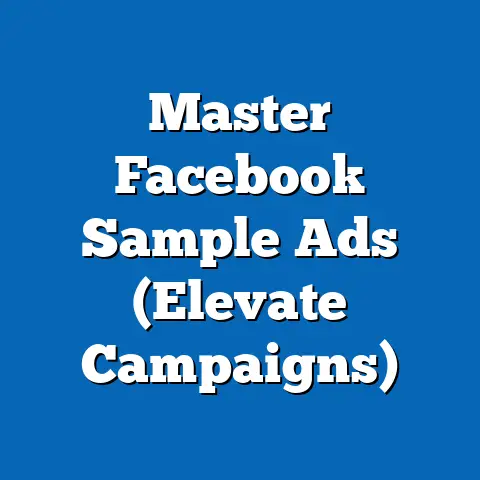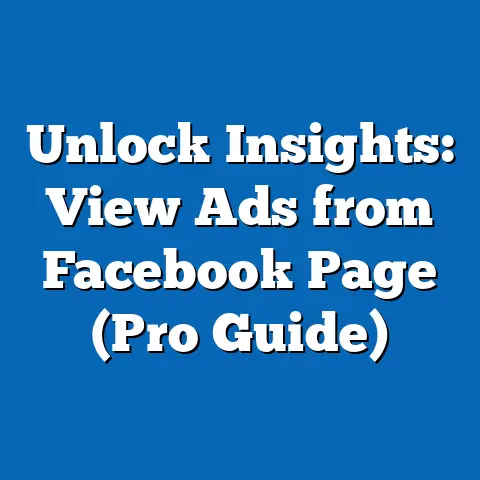Transform Facebook Image Ads: 10 Proven Strategies (Expert Insights)
1: The Power of Visual Content
Let’s face it, we live in a visually driven world. Our brains process images far faster than text, making visual content the king of grabbing attention. This holds especially true on platforms like Facebook, where users are bombarded with information every second.
Think about your own experience. What stops you from endlessly scrolling? It’s likely a captivating image or video, right? Statistics back this up. Studies show that Facebook posts with images see significantly higher engagement rates – likes, comments, shares – than those without. In fact, image ads, on average, receive double the engagement of text-based updates.
Beyond just grabbing attention, images have a powerful psychological impact. They can evoke emotions, tell stories, and create a lasting impression. Color psychology, for example, plays a huge role. Blue often conveys trust and stability, while red can evoke excitement and urgency. Using the right colors in your image ads can subconsciously influence how your audience perceives your brand and offer.
And let’s not forget Facebook’s algorithm. While the exact details are closely guarded, it’s clear that visually appealing content is favored. The algorithm prioritizes posts and ads that are likely to keep users engaged, and high-quality images are a key factor in achieving that goal. This means that by creating visually stunning image ads, you’re not just appealing to your audience; you’re also playing the algorithm game, increasing your ad’s reach and potential for success.
Takeaway: Visual content isn’t just “nice to have” – it’s essential for effective Facebook advertising. Invest time and resources in creating compelling images that capture attention, evoke emotion, and align with your brand.
2: Understanding Your Target Audience
Creating a beautiful image is only half the battle. If you’re showing it to the wrong people, it’s a wasted effort. This is where audience research comes in. Understanding your target audience – their demographics, interests, behaviors, and pain points – is crucial for creating image ads that resonate and drive conversions.
Think of it like this: you wouldn’t try to sell snow shovels in Miami, right? Similarly, you wouldn’t show an ad for luxury skincare to a group of college students on a tight budget.
So, how do you gather this crucial audience data? Thankfully, Facebook provides a wealth of tools and analytics.
- Facebook Audience Insights: This free tool provides aggregated information about your existing audience (those who like your page) and potential audiences based on demographics, interests, and behaviors.
- Facebook Pixel: Install the Facebook Pixel on your website to track user actions, such as page visits, purchases, and form submissions. This data allows you to create custom audiences based on specific behaviors.
- Lookalike Audiences: Leverage your existing customer data (email lists, website visitors) to create lookalike audiences. Facebook will identify users who share similar characteristics with your best customers, expanding your reach to highly relevant prospects.
- Surveys and Feedback: Don’t underestimate the power of directly asking your audience what they want. Run surveys on your Facebook page or website, or engage in conversations with your followers in the comments section.
I remember one campaign where we were struggling to reach our ideal customer. We thought we knew them well, but our ads weren’t performing as expected. After digging into Audience Insights, we discovered that our target audience was far more interested in a specific hobby than we had initially realized. By tailoring our image ads to reflect this interest, we saw a significant boost in engagement and conversions.
Takeaway: Never assume you know your audience. Continuously research and analyze your target demographic to create image ads that resonate with their specific needs and interests.
3: Crafting Compelling Visuals
Now that you understand your audience, it’s time to create visuals that grab their attention and hold it. This is where the art and science of design come into play. A compelling image ad isn’t just pretty; it’s strategically crafted to convey a message, evoke emotion, and drive action.
Here are some key elements of design to consider:
- Color Psychology: As mentioned earlier, colors have a powerful psychological impact. Choose colors that align with your brand identity and the emotions you want to evoke.
- Composition: The arrangement of elements within your image can significantly impact its effectiveness. Use the rule of thirds, leading lines, and negative space to create a visually balanced and engaging composition.
- Typography: Choose fonts that are legible, visually appealing, and consistent with your brand. Use font hierarchy to guide the viewer’s eye and highlight key information.
- Imagery: Select high-quality images that are relevant to your offer and resonate with your target audience. Avoid generic stock photos and opt for authentic imagery that reflects your brand’s personality.
- Branding: Ensure your image ads are consistent with your overall brand identity. Use your logo, colors, and fonts to create a cohesive brand experience.
Let me share an example. I worked with a local bakery that wanted to promote their new line of artisan breads. Instead of using generic photos of bread, we hired a professional photographer to capture stunning images of their products in a natural setting. We focused on highlighting the textures, colors, and aromas of the bread, creating images that were both visually appealing and mouthwatering. The result was a significant increase in sales and brand awareness.
Expert Tip: Don’t be afraid to experiment with different visual styles. Try different color palettes, compositions, and imagery to see what resonates best with your audience.
Takeaway: Invest time and resources in creating high-quality, visually compelling image ads that capture attention, convey your message, and align with your brand identity.
4: The Role of Messaging in Image Ads
While visuals are the hook, messaging is the line that reels your audience in. A concise and impactful message can complement your visuals, clarify your offer, and drive action.
Remember, you have limited space and time to capture attention on Facebook. Your message needs to be clear, concise, and compelling. Here are some tips for crafting effective messaging for your image ads:
- Highlight the benefits, not just the features: Focus on how your product or service will solve your audience’s problems or improve their lives.
- Use strong verbs and action-oriented language: Encourage your audience to take action with phrases like “Shop Now,” “Learn More,” or “Get Started.”
- Keep it short and sweet: Aim for a headline and description that are easy to read and understand at a glance.
- Personalize your message: Use language that resonates with your target audience’s specific needs and interests.
The call-to-action (CTA) is the final piece of the puzzle. It’s the instruction that tells your audience what you want them to do next. Make sure your CTA is clear, concise, and visually prominent. Use buttons or text that stand out from the rest of your ad and clearly indicate the desired action.
I once worked on a campaign for an e-commerce company that was struggling to generate leads. Their image ads were visually appealing, but their messaging was weak and their CTAs were buried in the text. By rewriting their ad copy to highlight the benefits of their product and adding a prominent “Shop Now” button, we saw a dramatic increase in click-through rates and lead generation.
Takeaway: Don’t underestimate the power of effective messaging. Craft concise, compelling copy that highlights the benefits of your offer and includes a clear call-to-action.
5: Leveraging A/B Testing for Optimization
Creating effective Facebook image ads is an iterative process. What works today may not work tomorrow. That’s why A/B testing is essential for continuously refining your ads and maximizing your ROI.
A/B testing, also known as split testing, involves creating two or more versions of an ad and showing them to different segments of your audience. By tracking the performance of each version, you can identify which elements are most effective and use that information to optimize your ads.
Here are some elements you can A/B test in your Facebook image ads:
Expert Insight: Don’t try to test too many elements at once. Focus on testing one or two variables at a time to get clear and actionable results.
Interpreting A/B test results requires careful analysis. Look at key metrics such as click-through rates, conversion rates, and cost per acquisition to determine which version of your ad is performing best. Use this data to inform future ad decisions and continuously refine your strategies.
Takeaway: Embrace A/B testing as an essential part of your Facebook advertising strategy. Continuously experiment with different elements of your ads to identify what works best and maximize your ROI.
6: Utilizing Facebook’s Creative Tools
Facebook provides a suite of creative tools that can help you enhance the quality of your image ads and streamline the creation process. These tools are designed to be user-friendly and accessible, even for those without extensive design experience.
- Facebook Ads Manager: This is your central hub for creating, managing, and tracking your Facebook ads. It provides a wide range of features for designing your image ads, including image cropping, text overlays, and CTA button customization.
- Creative Hub: This tool allows you to experiment with different ad formats and preview how your ads will look on various placements. It also provides inspiration and best practices for creating effective ad creatives.
- Facebook Pixel Helper: This Chrome extension helps you verify that your Facebook Pixel is installed correctly and tracking user actions on your website.
One of the most useful features of the Ads Manager is the ability to create multiple versions of your image ads with different text overlays and CTA buttons. This allows you to quickly A/B test different messaging options and optimize your ads for maximum performance.
Facebook is constantly updating its creative tools with new features and capabilities. Be sure to stay informed about the latest updates and take advantage of any new tools that can help you improve your image ads.
Takeaway: Leverage Facebook’s built-in creative tools to enhance the quality of your image ads, streamline the creation process, and stay ahead of the curve.
7: The Importance of Ad Placement
Where your ad appears on Facebook can significantly impact its performance. Facebook offers a variety of placement options, each with its own unique characteristics and audience.
- Facebook Feed: This is the most common placement option, where your ads appear in users’ news feeds alongside organic content.
- Instagram Feed: If you’re targeting a younger audience, Instagram Feed can be a highly effective placement option.
- Facebook Stories: These short, vertical videos and images are a popular way for users to share moments from their day.
- Instagram Stories: Similar to Facebook Stories, Instagram Stories offer a highly engaging and visual ad format.
- Audience Network: This extends your reach beyond Facebook and Instagram to a network of third-party apps and websites.
Different placements can affect ad performance in different ways. For example, ads in the Facebook Feed tend to have higher click-through rates, while ads in Facebook Stories tend to have higher engagement rates.
Expert Tip: Consider your target audience’s behavior when selecting your ad placements. If you’re targeting a younger audience, Instagram Stories may be a better option than Facebook Feed.
I once worked on a campaign for a mobile gaming app that was struggling to generate downloads. We initially focused on Facebook Feed placements, but our results were underwhelming. After experimenting with Instagram Stories placements, we saw a significant increase in downloads and user engagement. The vertical format of Instagram Stories was perfect for showcasing the gameplay and capturing the attention of our target audience.
Takeaway: Carefully consider your ad placements and choose the options that are most likely to resonate with your target audience and achieve your advertising goals.
8: Analyzing Performance Metrics
Tracking and analyzing your ad performance is essential for understanding what’s working and what’s not. Facebook provides a wealth of data that can help you measure the success of your image ads and identify areas for improvement.
Here are some key performance indicators (KPIs) to track:
- Reach: The number of unique users who saw your ad.
- Impressions: The number of times your ad was displayed.
- Click-through Rate (CTR): The percentage of users who clicked on your ad after seeing it.
- Conversion Rate: The percentage of users who completed a desired action (e.g., purchase, sign-up) after clicking on your ad.
- Cost Per Click (CPC): The average cost you pay for each click on your ad.
- Cost Per Acquisition (CPA): The average cost you pay for each conversion.
- Return on Ad Spend (ROAS): The amount of revenue you generate for every dollar you spend on advertising.
Measuring and analyzing these metrics effectively requires a systematic approach. Set clear goals for your campaigns and track your progress towards those goals. Use Facebook’s reporting tools to monitor your ad performance and identify trends.
Based on your performance data, you can adjust your ad strategies to improve your ROI. For example, if you’re seeing a low click-through rate, you may need to revise your ad copy or image. If you’re seeing a low conversion rate, you may need to optimize your landing page or offer.
Takeaway: Track and analyze your ad performance diligently to understand what’s working and what’s not. Use this data to adjust your ad strategies and improve your ROI.
9: Staying Ahead of Trends in Image Advertising
The world of social media advertising is constantly evolving. New trends emerge, algorithms change, and user behavior shifts. To stay ahead of the curve, it’s essential to stay updated with the latest trends in image advertising.
Here are some emerging trends to watch:
- Augmented Reality (AR): AR filters and lenses are becoming increasingly popular on Facebook and Instagram. These interactive experiences can engage users and drive brand awareness.
- Video Integration: Incorporating short videos into your image ads can capture attention and convey your message more effectively.
- Personalized Ads: Tailoring your ads to individual users based on their interests and behaviors can significantly improve engagement and conversions.
- Interactive Ads: Using interactive elements such as polls, quizzes, and games can encourage users to engage with your ads and learn more about your brand.
I recently saw a campaign from a furniture retailer that used AR filters to allow users to virtually place furniture in their homes. This innovative approach not only engaged users but also helped them visualize the product and make a purchase decision.
Expert Insight: Don’t be afraid to experiment with new trends, but always test them thoroughly before investing heavily.
Staying updated with Facebook’s advertising policies and features is also crucial. Facebook regularly updates its policies and introduces new features. Make sure you’re aware of these changes and adapt your strategies accordingly.
Takeaway: Stay informed about the latest trends in image advertising and Facebook’s advertising policies. Embrace innovation and adapt your strategies to stay ahead of the curve.
10: Real-World Case Studies
Learning from the success of others is a powerful way to improve your own advertising strategies. Let’s take a look at some real-world case studies of brands that have successfully transformed their Facebook image ads.
- Dollar Shave Club: Known for their witty and irreverent humor, Dollar Shave Club uses image ads that are both visually appealing and highly engaging. Their ads often feature relatable scenarios and humorous taglines that resonate with their target audience.
- Airbnb: Airbnb uses stunning photography to showcase their unique properties and inspire wanderlust. Their image ads often feature breathtaking landscapes and cozy interiors that entice users to book their next vacation.
- Warby Parker: Warby Parker uses clean and minimalist design to showcase their stylish eyewear. Their image ads often feature models wearing their glasses in everyday settings, creating a relatable and aspirational brand image.
These case studies demonstrate that there’s no one-size-fits-all approach to Facebook image advertising. However, they all share some common characteristics:
- High-quality visuals: All of these brands invest in creating visually appealing images that capture attention and convey their brand message.
- Compelling messaging: They all craft concise and compelling copy that highlights the benefits of their products or services.
- Clear call-to-action: They all include a clear call-to-action that tells users what they want them to do next.
- Targeted advertising: They all target their ads to specific audiences based on their demographics, interests, and behaviors.
Takeaway: Draw inspiration from successful brands and apply similar strategies to your own Facebook image advertising campaigns.
Conclusion
Transforming your Facebook image ads requires a blend of creativity, data analysis, and adaptability. By implementing these 10 proven strategies, you can create ads that capture attention, engage your audience, and drive real results. Remember to continuously refine your strategies based on insights and performance metrics, ensuring your image ads remain compelling and effective in reaching your target audiences.
The key takeaways are:
- Embrace the power of visual content: Invest in high-quality images that capture attention and evoke emotion.
- Understand your target audience: Research and analyze your audience to create ads that resonate with their specific needs and interests.
- Craft compelling visuals: Use the elements of design to create visually balanced and engaging compositions.
- Master the art of messaging: Craft concise and compelling copy that highlights the benefits of your offer.
- Leverage A/B testing: Continuously experiment with different elements of your ads to identify what works best.
- Utilize Facebook’s creative tools: Take advantage of Facebook’s built-in tools to enhance the quality of your image ads.
- Choose the right ad placements: Carefully consider your ad placements and select the options that are most likely to resonate with your target audience.
- Analyze performance metrics: Track and analyze your ad performance to identify areas for improvement.
- Stay ahead of trends: Stay informed about the latest trends in image advertising and adapt your strategies accordingly.
- Learn from real-world examples: Draw inspiration from successful brands and apply similar strategies to your own campaigns.
Now, go out there and transform your Facebook image ads! I’m confident that with these strategies, you’ll see a significant improvement in your advertising performance. Good luck!

